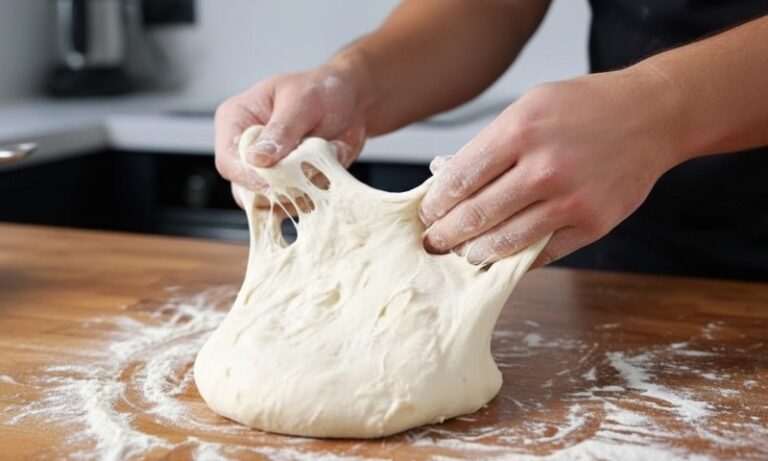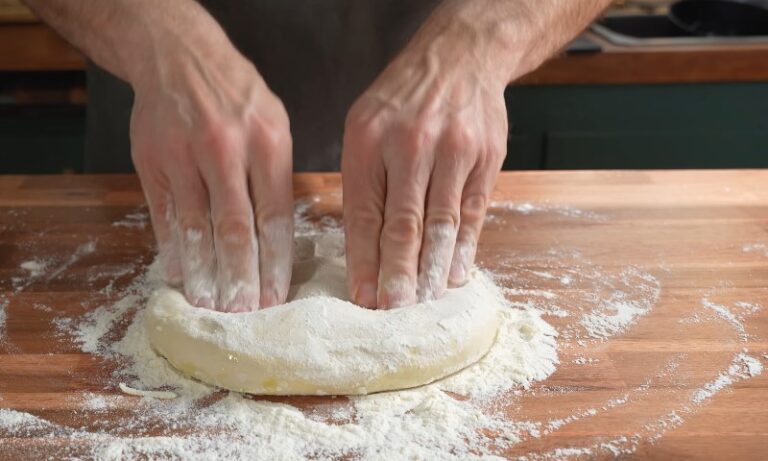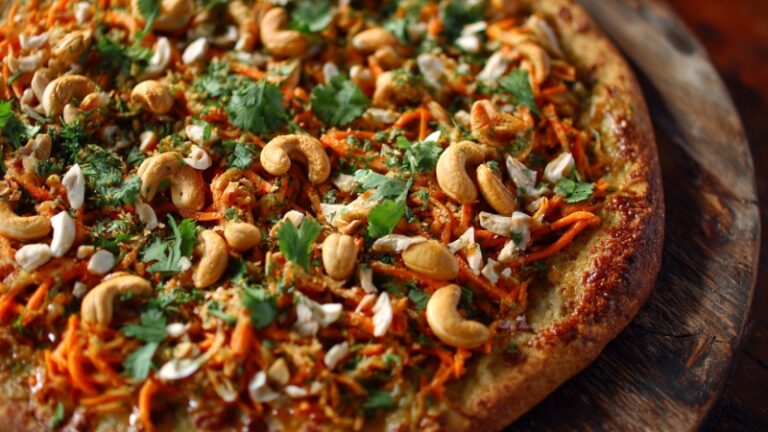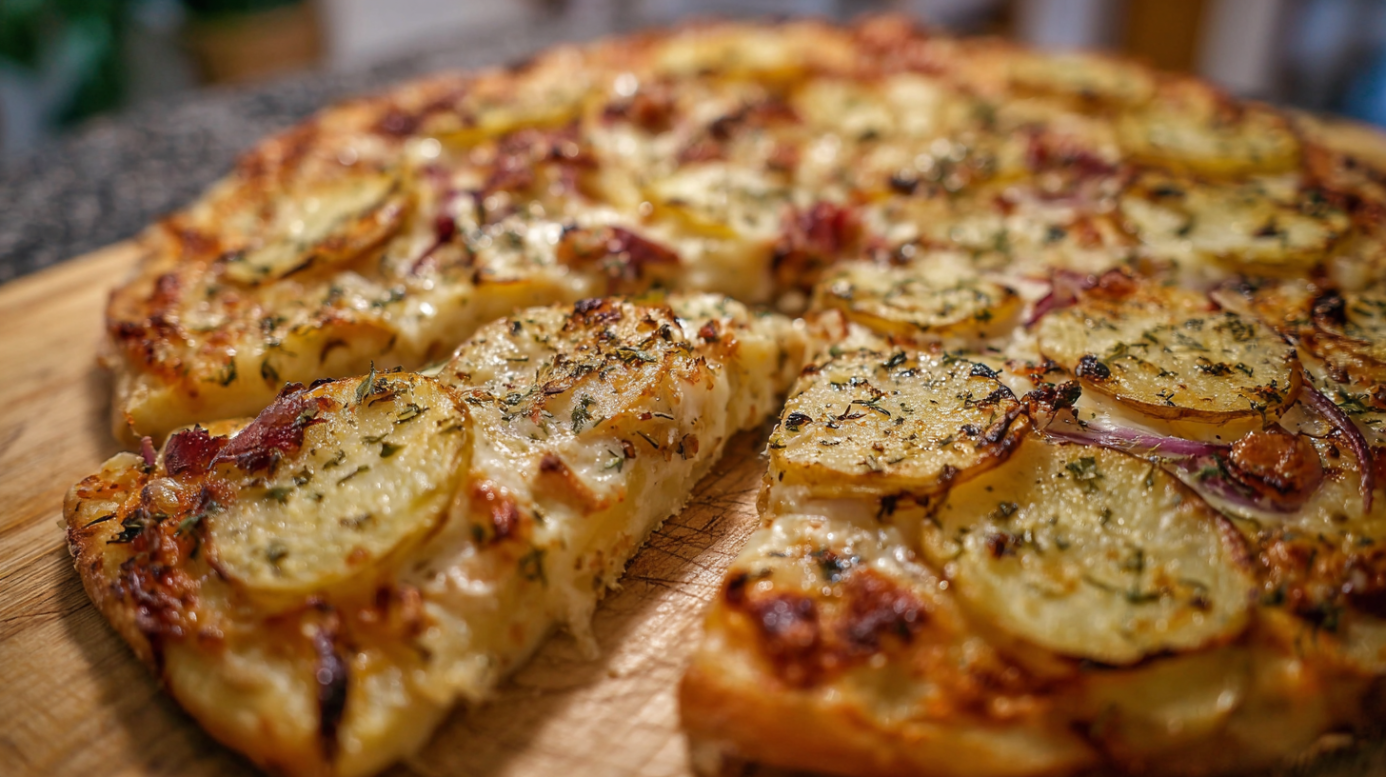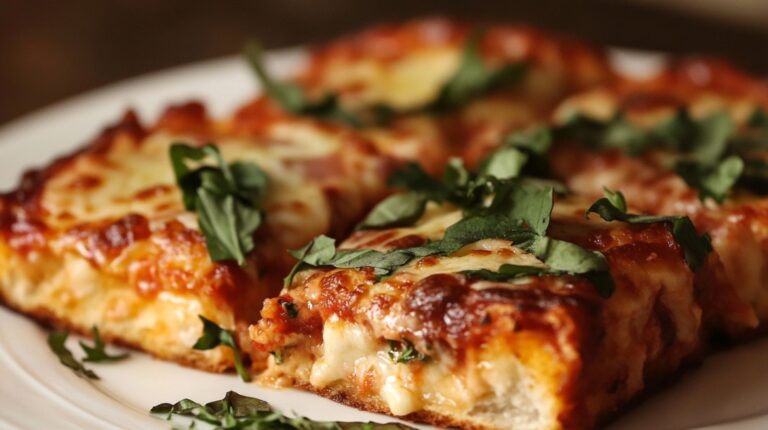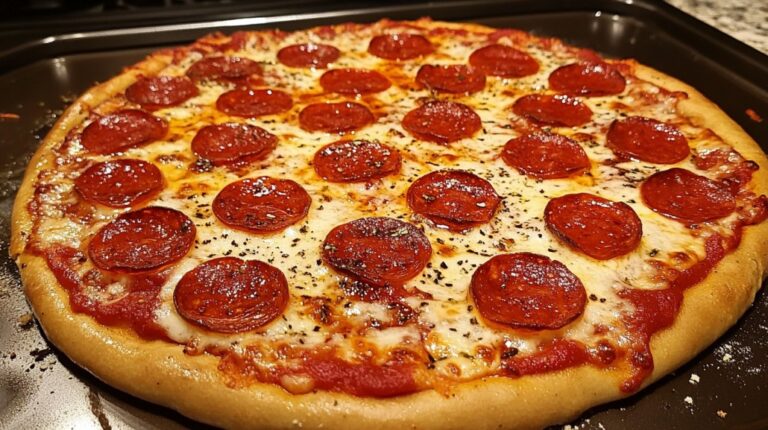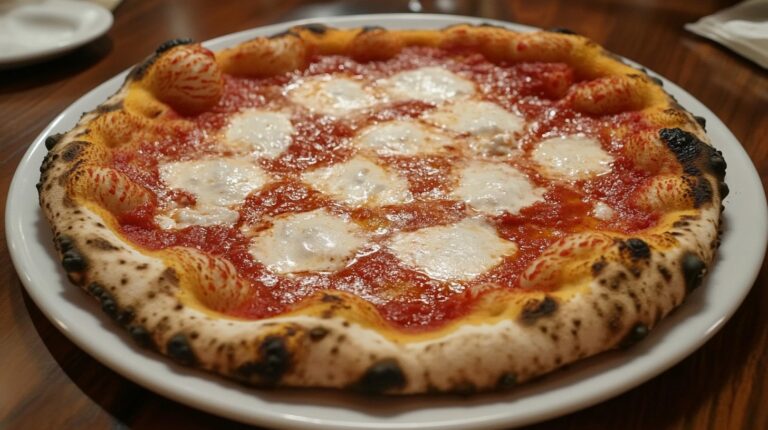Potato pizza might sound unusual to American diners, but food enthusiasts and pizza makers worldwide are discovering what Italians have known for decades: the benefits of this unique combination.
Pizza industry reports from 2024 indicate that potatoes have emerged as one of the trending pizza toppings being tested by pizzerias, and early indicators suggest this humble vegetable could become a major pizza trend in 2025.
You’ll learn about the rich history behind pizza with potatoes, explore different preparation methods, discover trending pizza flavors that incorporate potatoes, and get practical tips for making your homemade potato pizza.
Table of Contents
ToggleThe Rise of Unconventional Pizza Toppings in 2025
Pizza trends have undergone significant shifts over the past few years. Industry experts note that pizza is getting back to its roots with classic toppings, but with an upgraded element that can range from unique cheese blends to premium olive oil or fresh ingredient finishes.
Pizza crusts are being reimagined to cater to various dietary preferences and creative impulses, with gluten-free options such as cauliflower and chickpea crusts, as well as indulgent crusts infused with flavors like garlic or herbs.
Potato pizza fits perfectly into contemporary food movements. Restaurants and home cooks are embracing vegetarian pizza recipes that offer comfort and substance without the use of meat. Gourmet pizza ideas now include vegetables that were once considered unconventional, and potatoes provide the perfect bridge between familiar flavors and culinary adventure.
The timing appears perfect for potato-based pizzas to gain mainstream acceptance. Food service professionals report growing demand for unique pizza toppings that offer both novelty and satisfying flavors. Potatoes deliver on both fronts, providing creamy texture and earthy taste that complements traditional pizza elements.
Italian Roots: The Authentic History of Pizza con Patate
This simple pizza style, featuring sliced potatoes on thin dough, hails from Italy, where it is known as pizza con patate. It is popular in Rome, but regional variations include the addition of sauce or cheese. Italian potato pizza embodies centuries of culinary expertise, showcasing how simple ingredients can yield extraordinary results.
Regional differences exist throughout Italy, with southern regions incorporating mashed potatoes into pizza crust to make it soft and tender. At the same time, other areas use potato chunks as toppings, often paired with cheese.
Northern Italian regions frequently feature thin-sliced potatoes layered over pizza bianca, usually enhanced with rosemary and high-quality olive oil.
The Roman tradition of pizza al taglio (pizza by the slice) frequently features potato as a primary topping. Street vendors and pizzerias throughout Rome serve rectangular pizza topped with paper-thin potato slices, fresh herbs, and coarse sea salt. This style has remained consistent for generations, proving the enduring appeal of potatoes on pizza.
Roman pizza makers perfected techniques that ensure potatoes cook evenly without burning. They discovered that soaking thin potato slices in salted water softens the texture and reduces cooking time. The result is creamy potato pieces that contrast beautifully with crispy pizza crust.
Popular Potato Pizza Variations Around the World
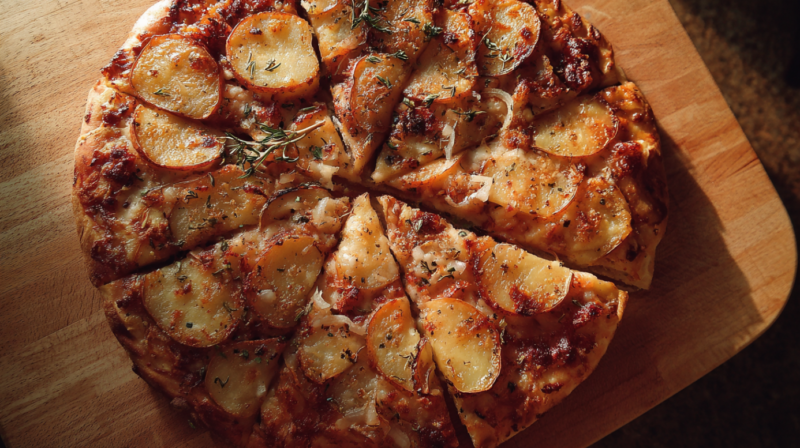
Classic Italian Style
Traditional Italian potato pizza features ultra-thin slices of potato arranged over pizza dough, accompanied by rosemary, olive oil, and coarse salt.
No sauce or cheese is added to authentic versions, allowing the potato flavors to dominate. The simplicity creates an elegant dish that highlights quality ingredients.
American Adaptations
American pizzerias have embraced potato pizza with creative modifications. Many versions include cheese, typically mozzarella or white sauce bases.
Some establishments add bacon, caramelized onions, or sour cream to create loaded potato pizza experiences that appeal to comfort food preferences.
Crispy Potato Crust Pizza
Innovation extends beyond toppings to pizza bases themselves. Crispy potato crust pizza utilizes grated potatoes formed into crusts, creating gluten-free alternatives that maintain a satisfying texture.
These crusts require careful preparation to achieve proper binding and prevent them from becoming soggy.
Potato Flatbread Pizza
Mediterranean-inspired versions combine potato toppings with flatbread bases. These lighter options work well for lunch or appetizer portions.
Potato flatbread pizza often features Mediterranean vegetables, herbs, and olive-based sauces that complement the flavors of potatoes.
Pizza Style
Base
Toppings
Origin
Pizza con Patate
Traditional dough
Thin potato slices, rosemary, olive oil
Rome, Italy
American Loaded
Pizza dough
Potatoes, cheese, bacon, onions
United States
Crispy Crust
Potato-based crust
Various toppings
Modern fusion
Flatbread
Flatbread base
Potatoes, Mediterranean vegetables
Mediterranean
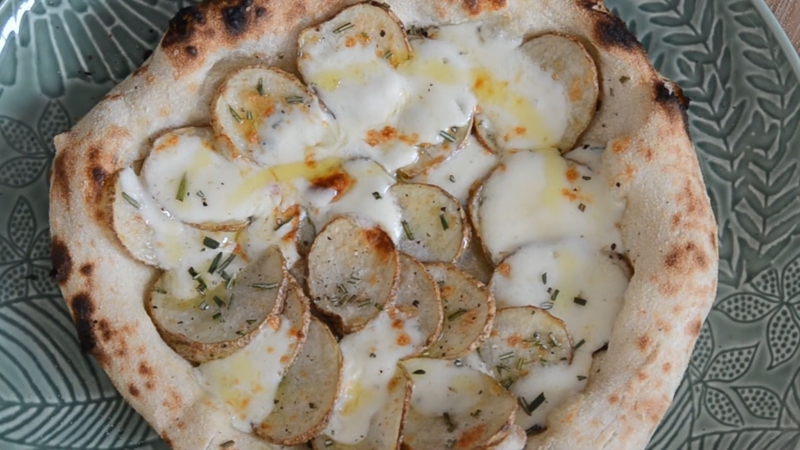
Perfect Homemade Potato Pizza (Pizza con Patate)
Equipment
- Oven
- Baking sheet or pizza stone
- Parchment paper
- Rolling pin
- Mixing bowl
- Mandoline slicer (recommended) or sharp knife
- Pizza peel (optional)
Ingredients
- 1 ball of pizza dough (enough for one 12-inch pizza)
- 2 medium Yukon Gold potatoes, peeled and very thinly sliced
- 2 tbsp extra virgin olive oil, plus more for drizzling
- 1 tsp fresh rosemary, finely chopped
- ½ tsp flaky sea salt (or to taste)
- Freshly ground black pepper, to taste
- 2 tbsp grated Parmigiano-Reggiano or Pecorino Romano (optional)
Instructions
- Preheat & Prep DoughPreheat your oven to 475°F (245°C). If using a pizza stone, place it in the oven. Roll out the pizza dough into a 12-inch round on a floured surface, then transfer it to a parchment-lined baking sheet or pizza peel.

- Slice & Season PotatoesPeel and thinly slice the Yukon Gold potatoes using a mandoline or sharp knife. Toss them in a bowl with 2 tablespoons olive oil, chopped rosemary, flaky sea salt, and freshly ground black pepper.
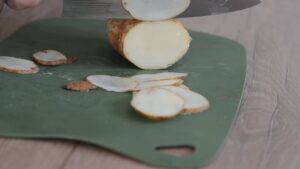
- Assemble PizzaLayer the seasoned potato slices over the dough, slightly overlapping to cover the entire surface. Drizzle with a little extra olive oil and, if desired, sprinkle grated Parmigiano-Reggiano or Pecorino Romano on top.

- BakeBake the pizza for 12–15 minutes until the crust is golden brown and crisp, and the potatoes are tender with slightly crisped edges.

- Finish & ServeLet the pizza rest for 2 minutes after baking, then slice and serve hot. Enjoy as a main dish or a flavorful appetizer!

Video
Notes
Cooking Tips
- Use a mandoline for paper-thin, consistent potato slices.
- Yukon Golds are perfect for their creamy texture and buttery flavor.
- For a gourmet version, drizzle with truffle oil or add caramelized onions.
- Bake directly on a hot pizza stone or steel for an extra-crispy crust.
Where Potatoes Fit
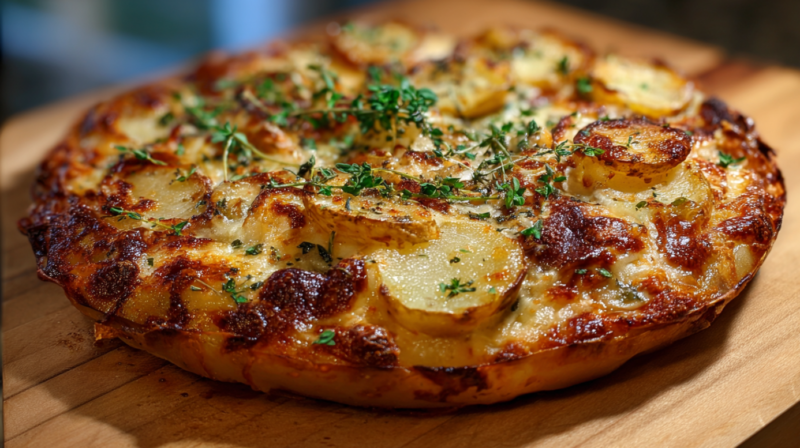
Current food trends strongly favor vegetables in unexpected contexts. Pizza concepts went wild for pickles and hot honey in 2024, with both topping choices experiencing year-over-year growth according to industry data. Potatoes represent the next logical step in the evolution of vegetable pizza.
Sustainability concerns drive many 2025 food trends. Eco-friendly, locally sourced toppings help restaurants reduce their carbon footprints, while plant-based options meet the rising demand for vegan cheeses and meat substitutes. Potatoes excel in both categories, offering local sourcing opportunities and satisfying substance for plant-based diets.
Social media influence cannot be ignored in pizza trends. Potato pizza photographs beautifully, with golden potato rounds creating visually appealing patterns. Food bloggers and influencers have begun featuring potato pizza recipes, expanding awareness among younger demographics.
Restaurant profit margins benefit from offering potato pizza. Potatoes cost significantly less than premium meats or imported cheeses, yet command similar menu prices when presented as gourmet pizza ideas. This economic advantage encourages restaurant adoption.
Nutritional Benefits and Dietary Considerations
Potatoes offer substantial nutritional value, which is often overlooked in pizza contexts. A medium potato contains approximately 160 calories, 4 grams of protein, and significant amounts of potassium, vitamin C, and vitamin B6. When prepared without excessive oil, potato pizza can be relatively healthy.
Vegetarian and vegan diners appreciate options featuring potato pizza. Traditional versions contain no animal products, making them suitable for those following a plant-based diet. The substantial nature of potatoes provides satisfying alternatives to meat-based pizzas.
Gluten-sensitive individuals can enjoy potato-crusted versions that eliminate wheat. Properly prepared potato crusts offer a suitable texture while avoiding gluten-related digestive issues. However, traditional pizza dough versions remain unsuitable for celiac disease.
Portion control becomes easier with potato pizza because the vegetable provides natural satiety signals, helping you feel full. Diners often feel satisfied with smaller portions compared to cheese-heavy alternatives, which may support weight management goals.
Pro Tips and Techniques
@iamjumo potato pizza #pizza #jersey #italianamerican #molinaris ♬ เสียงต้นฉบับ – John (Songs Station) – สุขภาพดีกับเภเบิร์ด
Equipment Recommendations
Mandoline slicers produce the most consistent potato thickness, crucial for even cooking. If using knives, maintain steady hand pressure and slice potatoes immediately before use to prevent browning. Pizza stones or steel surfaces create superior crust textures compared to standard baking sheets.
Ingredient Selection
Choose potatoes based on desired final texture. Waxy varieties create creamier results, while starchy potatoes develop fluffier interiors. Avoid potatoes with a green tint or sprouts, as they can form bitter flavors. Store potatoes in cool, dark places before use.
Common Mistakes to Avoid
Overcrowding potato slices leads to steaming rather than proper browning. Leave small gaps between slices for air circulation. Skipping the soaking step results in unevenly cooked potatoes that may remain hard in the centers. Always pat potatoes completely dry to prevent soggy crusts.
Flavor Enhancement Ideas
Experiment with herb combinations beyond traditional rosemary. Thyme, oregano, or sage complement the flavors of potatoes beautifully. Garlic powder or minced fresh garlic adds depth without overwhelming the delicate taste of potatoes. Parmesan cheese works well for those preferring cheese additions.


